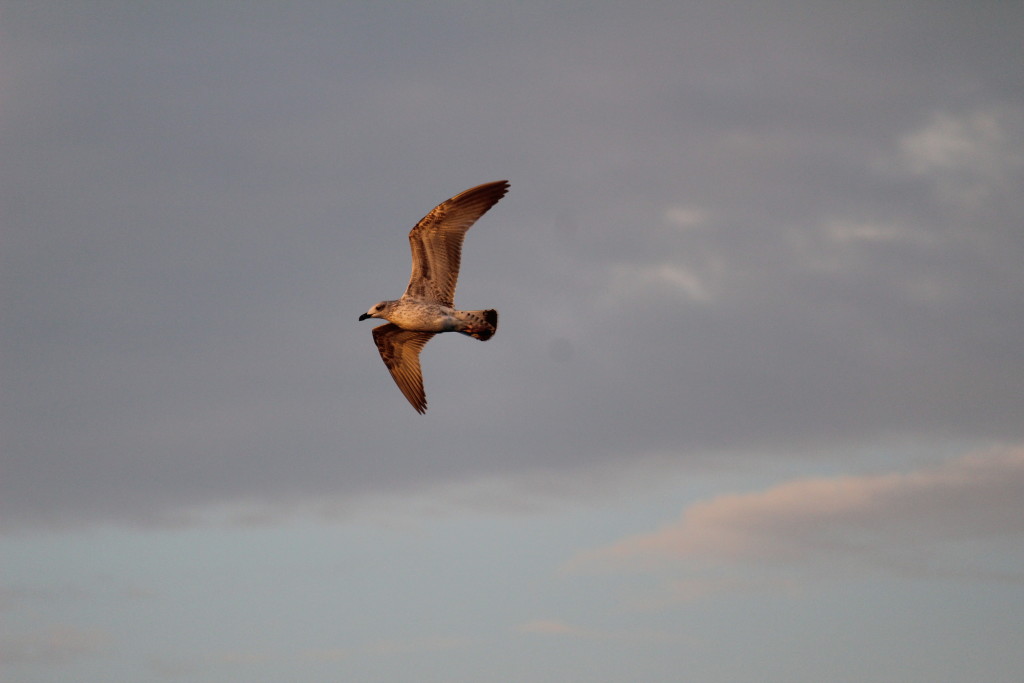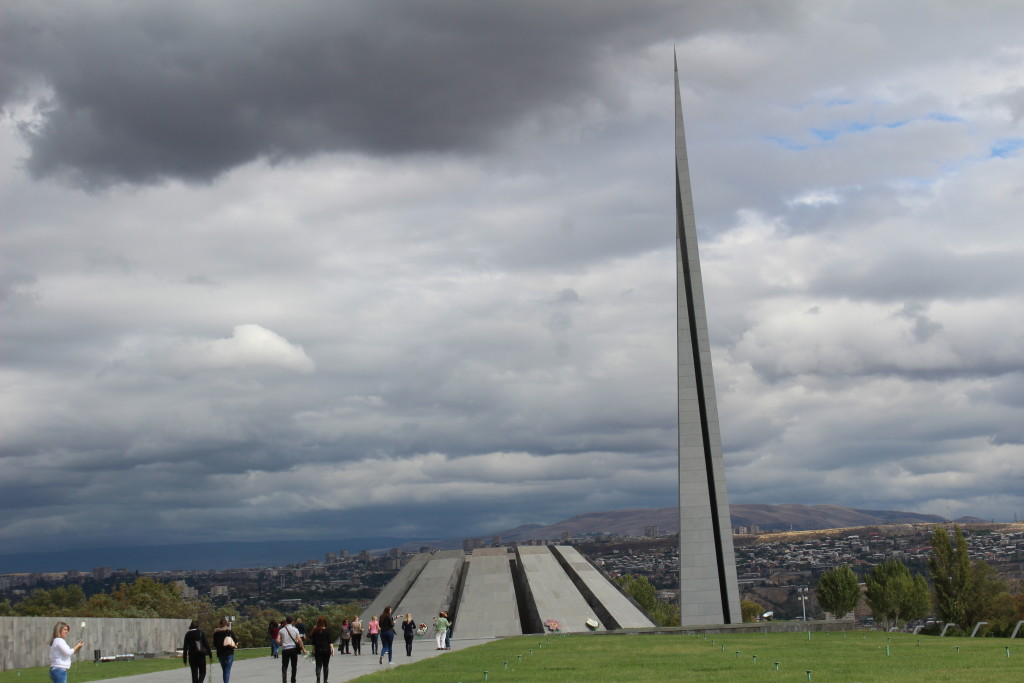We leave Russia and enter Georgia without visa, passing Kazbegi border check point on Caucasian Mountains. Then we start hitchhiking towards Tbilisi on the road between mighty Kazbek and Shani mountains, following the Valley of Terek River, which is being blocked due to landslides time by time. When we reach Tbilisi with a family from Azerbaijan, Andro welcomes us to his home, who we met on Counchsurfing.
Tbilisi is a 1500 years old modern city. In the city center around Kura River, there are historical buildings look like built on each other, surrounded by skyscrapers.
Bathhouses and buildings around sulfur water resource in the center of the city are restored and used as hotels and restaurants. But when we start walking in narrow streets and leave the touristic center, we run into abandoned historical churches and houses.
A waterfall in the city completes the beauty of historical Tbilisi. The waterfall comes from the top of a cliff and presents an extraordinary view for a city.
The metro line built in Soviet era covers most of the city but the best way to explore Tbilisi is walking anyway. Decades old books exposed by second hand book seller on streets, small statutes on pavements, mosaics on the wall of a clock tower…
While walking on Rustaveli street, the most famous street of the city with magnificent Soviet buildings, we run into a tea garden and decide to rest. But this is actually a beer garden and the price of a cup of coffee is twice more expensive than beer; and a big glass of beer is just 1.70 Lari. We are in the right place to get full of beer before going to Iran.
Andro’s house becomes an opportunity to meet fellow travellers. For one night, we share home with Maria, Ben and Mathew before they go to Turkey. Maria and Ben have been travelling for a long time and explored central and south Asia by hitchhiking after selling their bicycles in Iran. You can follow their adventures on www.wonderlusters.com.
After three days we spent in the capital of Georgia, we hit the road towards Mestia to explore Caucasian Mountains in the north. We plan to reach Mestia by hitchhiking after taking train to Zugdidi but we change our route and go to warm shores of Black Sea when we learn that it is getting cold and heavy rains start in October. In Bird Day, we camp next to the lake in Kolkheti National Park and observe birds in the birds’ paradise of Georgia.
When we go further south and reach Buknari, enter subtropical climate near Black Sea. Banana and date trees, tea and hazelnut gardens, warm and humid weather… We feel like we are back to Sri Lanka when continuous rain starts.
It is very easy to hitchhike in Georgia, and we continue travelling just by hitchhiking. Most of the people know English, Turkish or Russian, thus we can communicate easily. We are invited to a home for a tea while gathering dates from a tree. They treat us with delicious tea and hazelnuts grew in their own garden.
While approaching Batumi, modern high buildings of the city greet us. But when we get far from the shore, we go behind the view of window dressing. We stay in Keti Guesthouse for 15 Lari for one night on a dirt road among signs in Russian and Turkish.
The following day we move to the house of Heracles, who we met on the street and invited. When we start exploring Batumi and walking on streets among well-kept Soviet buildings and older churches we have just one thing in our minds; finding a cheap bakery to eat “Khachpuri”, national symbol of Georgia.
Khachapuri is some kind of bread filled with cheese, and the one with eggs is called Adjaruli Khachapuri. Adjaruli is the name of a region in Georgia, capital of which is Batumi. So, Batumi is the best place to eat it. We start following a lady with lots of Khachapuri and get satisfied.
Then we start walking on well-designed coastline of Batumi with parks, beaches and some skyscrapers and meet Ali and Nino.
After two nights in Batumi, we hit the road again towards Armenia. While hitchhiking on the road following Choruh Valley, we face with HEPP construction sites on the river. Construction work is held by a Turkish company. We meet the engineers and drink tea in the construction site. Even in Georgia, Choruh cannot flow free.
Goderdzi pass before Akhaltsikhe is very high and tough. The road over 2000 meters takes time and when we reach Akhaltsikhe it gets dark and we camp next to a river quickly.
The following day, we are planning to pass Armenian border but when we hear about Vardzia on our way, we decide to stay in Georgia for one more day. Vardzia, 16 kilometers from Khertvisi, is a historical settlement with tens of caves on a steep hill in the valley shaped by Kura River. It is exciting to explore the caves connected to each other with stairs and tunnels, but it is highly touristic.
We spend the night with our dog friend in our camp next to the historical settlement.
In the morning, the weather reminds us that we are in October. We reach the border of Armenia by hitchhiking under dark clouds and rain. The border pass is not busy but the officers are very kind and smiling on both sides of the border. We get our 21 days visa for 3000 Drams from the officer welcoming us in Turkish and enter Armenia.
We hitchhike again and reach Gyumri thanks to an Armenian friend who invites us to his car. From Gyumri we take a minibus for 1500 Dram and reach Yerevan in the evening. Thanks to Couchsurfing, we have a friend there. We are hosted by Bahram who lives there for a while for studying
In our first day in Yerevan, we visit Tsitsernakabert Genocide Museum at the top of a high hill in the city. It is the 100th anniversary of the genocide in 1915, and streets are full of Armenian flags and posters saying “I Remember and Demand”.
Tsitsernakabert is consisted of a 44 meters high stele symbolizing rebirth of Armenians and a circle of 12 slabs positioned in a circle symbolizing lost provinces. At the center of the circle, there is an eternal fire where visitors place flowers. When we were there, a group of students were commemorating the genocide.
Trees between the monument and the museum are planted in memory of people died in Armenian Genocide. A plate is placed under each tree with the name of the donator person or organization.
Genocide Museum covers the period starting from the beginning of World War I to Lausanne Conference. It takes hours to read and examine everything in the museum with 2 floors and 10 galleries. Hundreds of photographs and documents from the era between İttihat ve Terakki (Comitee of Union and Progress) and the Republic… At the end of the exhibition, there is a quote by Adolf Hitler on the wall, dating back to 1939, just before the invasion of Poland: “Who, after all, speaks today of the annihilation of the Armenians?”
Mount Ararat can be seen from many high points of Yerecan like the hill of Tsitsernakabert. But it can only be seen, not visited, because of closed borders. Ararat, an important image in Armenian history and culture, looks really legendary from Armenia.
After 4 days in Yerevan, our journey starts towards the south to go to Iran. We hitchhike on high mountains and deep valleys. If no one stops for a long time, Ebru sings a song and a car slows down for us. If there are rain clouds on the sky, she sings again and disperses them.
After staying for one night in a beautiful mountain town called Goris, we leave Armenia and start exploring Iran; the 12th country on the 12th month of our trip…

























